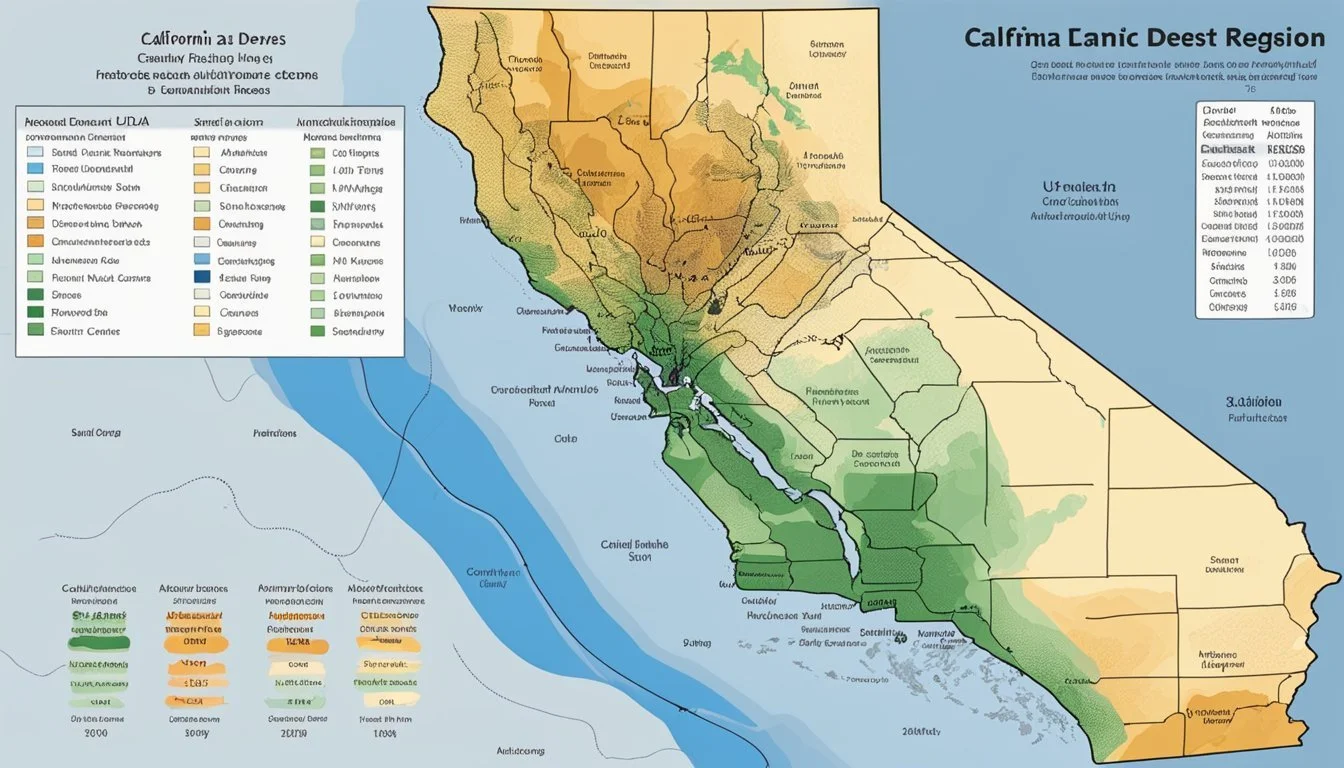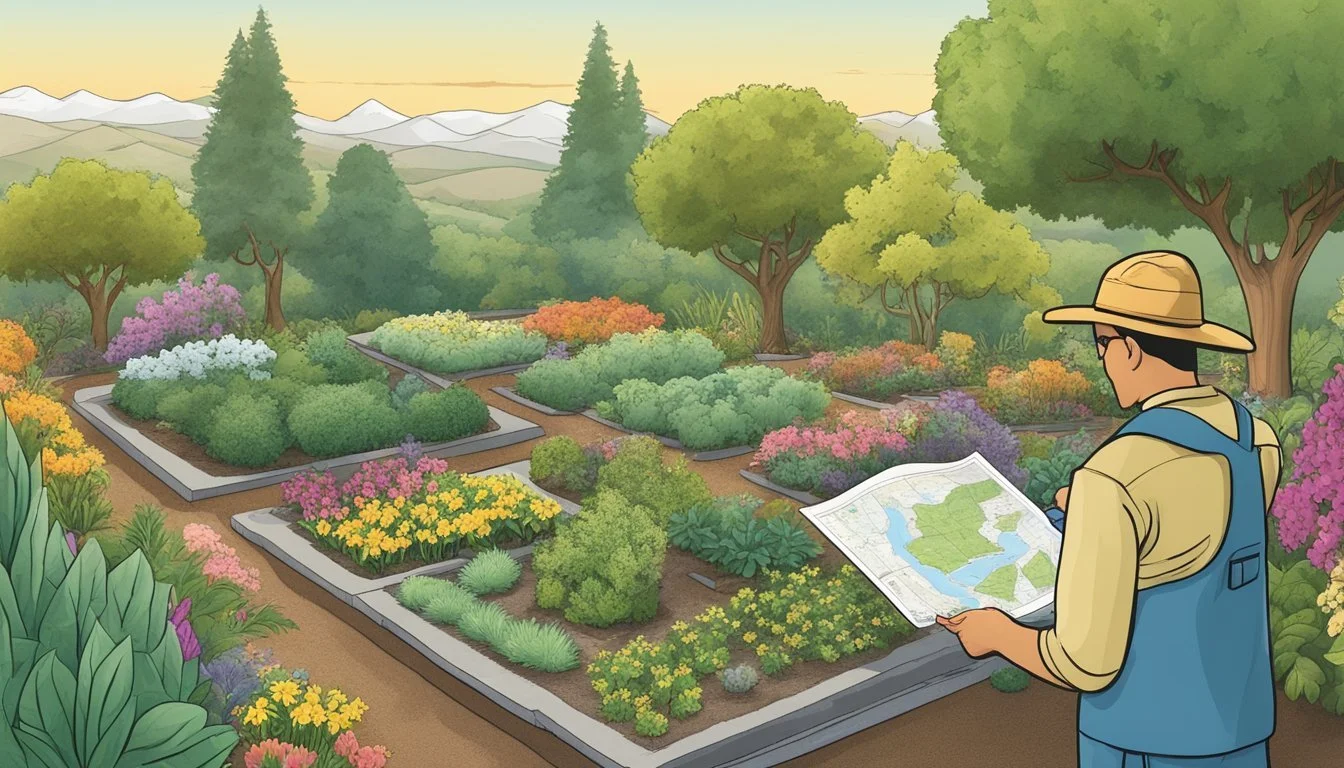USDA Hardiness Zones in California
A Guide to Successful Gardening
Understanding the USDA Hardiness Zones is crucial for gardeners and agriculturists in California as it guides them in determining the most suitable plants to cultivate. These zones are delineated by the U.S. Department of Agriculture and are based on the average annual extreme minimum temperatures. The USDA Plant Hardiness Zone Map is a vital resource that has been recently updated to reflect changes in climate patterns. The map segments into zones that are represented by 10-degree Fahrenheit divisions, further refined into 5-degree Fahrenheit half zones, providing detailed guidance for plant selection.
California's diverse climate means that it spans several hardiness zones, offering a varied palette of planting options for the state's gardeners. From the cooler, wetter regions of the northern part of the state to the warmer, drier southern areas, the range of plant hardiness zones across California is broad. Specific information about these zones, such as the California Interactive USDA Plant Hardiness Zone Map by Plantmaps, presents a comprehensive look at the zones specific to California, assisting gardeners in making informed choices for their landscapes.
The adaptation of plants to local conditions is a cornerstone of successful gardening, and the USDA Hardiness Zone Map makes this process more precise. By correlating plant varieties with the zones where they have the best chance to thrive, gardeners can invest their efforts into cultivating a garden that grows robustly year after year. For further insights into planting zones within California, including first and last frost dates, Gardening Know How offers resources to understand the specific requirements for planting and maintaining a healthy garden tailored to California's unique climate zones.
Understanding USDA Plant Hardiness Zones
The USDA Plant Hardiness Zone Map is an essential tool for gardeners, landscapers, and agricultural professionals across the United States. Published by the U.S. Department of Agriculture's Agricultural Research Service, this map divides the country into different growing zones based on the average annual extreme minimum temperature. Specifically, it helps to identify which plants are more likely to thrive in a given location.
The latest 2023 map incorporates climate data from weather stations and input from scientists to offer an updated guide for planting and cultivation. Each zone on the map represents a 10-degree Fahrenheit range of minimum temperatures, with subdivisions providing an additional layer of precision with 5-degree increments.
California's diverse climates, for example, are reflected in multiple hardiness zones ranging from the chillier Zone 5 (which can reach -20°F) to the balmy Zone 11 (which typically does not dip below 40°F). Gardeners can refer to this map to determine the suitability of specific plants for their locale.
It's important to understand that while the USDA hardiness zones serve as a strong foundational reference, local variations such as elevation, rainfall, and microclimates can also influence a plant's success. Therefore, the zones should be used as a guide rather than an absolute rule.
By consulting the current USDA Plant Hardiness Zone Map, individuals can make informed decisions to foster a healthy and vibrant garden tailored to their specific regional conditions.
California's Climatic Regions and Their Zones
California's diverse topography gives rise to a wide range of climatic conditions, each designated by unique USDA Hardiness Zones that guide planting and gardening.
Coastal Regions
The Coastal Regions of California are known for their mild, Mediterranean climate. Zone 10b, with average minimum temperatures ranging from 35°F to 40°F, encapsulates much of this area. The coast benefits from steady ocean breezes which moderate the heat, contributing to a stable microclimate ideal for a variety of plants.
Inland Areas
Moving inland, the areas experience a greater range of temperatures. Zones 8a through 9b are typical in these regions, with cooler winters and hotter summers. The inland areas lack the moderating effects of the ocean, leading to more pronounced seasonal temperature fluctuations, especially evident in the heat during summer months.
Mountainous Terrain
Mountainous Terrain in California falls into Zones 5 and 6, encountering some of the coldest temperatures in the state. The Sierra Nevada mountains, for example, can reach minimum temperatures of -20°F to -10°F, which defines the harshness of the winter and the resilience required by plant life.
Desert Regions
In contrast, California's Desert Regions like the Mojave Desert are assigned to Zone 11, the warmest USDA Hardiness Zone present in California, indicating extreme heat resistance is necessary for vegetation. This area is characterized by low annual precipitation and intense heat, where only the hardiest desert-adapted plants can thrive.
Using the Hardiness Zone Map for Gardening
Gardeners often turn to the USDA Plant Hardiness Zone Map as a fundamental tool to guide their planting decisions. This map delineates areas defined by their average annual extreme minimum temperatures—critical information for selecting plants, including vegetables, flowers, and perennial plants that can thrive in a particular location's climate.
California's diversity in climate is represented through a range of zones—from Zone 7 to Zone 13. These zones are indicative of the minimum temperatures one might expect:
Zone 7: 0°F to 10°F
Zone 13: Above 60°F
When gardeners and growers are planning their gardens, it’s essential to choose plants that are suited to the local zone.
For example, a gardening enthusiast in Zone 7 might select a hardy perennial that can withstand cooler temperatures, whereas a Zone 13 gardener will prioritize plants that can endure much warmer conditions.
Here’s a simple guideline:
Vegetables: Certain cool-season vegetables can be grown in Zone 7 where lower temperatures prevail.
Flowers: Many flowers, especially native species, will flourish when matched with their ideal hardiness zone.
The zone map is not only about temperatures; it also indirectly informs about factors such as humidity and soil freeze depth which are related to these temperature ranges.
Plants are generally labeled with their planting zone specifications, allowing growers to make informed choices about the species most likely to succeed in their gardens. It's crucial to note that the hardiness zone is a starting point, and local variations such as microclimates, soils, and elevation also play a significant role in gardening success.
Impact of Hardiness Zones on Perennials, Trees, and Flowers
USDA Plant Hardiness Zones are crucial for gardeners and landscapers in California, as they guide the selection of plants that are most likely to thrive in specific regions. Generally, these zones are determined by the average annual minimum winter temperature of an area.
For perennial plants, hardiness zones are a key indicator for survival and blooming consistency. Perennials suited to a specific zone have a greater chance of surviving the winter and returning each spring. Thus, matching perennials with their respective zones is vital for a successful garden.
When considering trees, including fruit and ornamental varieties, the hardiness zone informs growers about which species can tolerate their local climate extremes. For instance, trees that are suitable for Zone 9 may not withstand the lower temperatures of Zone 7 without adequate protection.
Flowers, both annual and perennial types, rely on zone information for optimal growth. Seasonal flowering times and the duration of blooms are influenced by temperature and climate conditions outlined by the hardiness zones. This is particularly important for breeding programs and for gardeners aiming for continuous color throughout seasons.
In light of changing climates, gardeners are beginning to notice a shift in these zones as highlighted by the 2023 USDA Plant Hardiness Zone Map. It’s now more important than ever to monitor these changes, as they may affect plant selection and garden management practices in the long term.
Zone Variability: Careful selection of perennials, trees, and flowers according to California's varied zones ensures better growth and longevity.
Temperature Influence: Even slight variations in minimum temperatures can impact plant survivability.
Climate Change Adjustments: Gardeners may need to adapt their plant choices as hardiness zones gradually shift.
Seasonal Considerations and Planting Timeframes
In California, the growing season can vary widely due to the state's diverse climates and plant hardiness zones. Gardeners should carefully consult the 2023 USDA Plant Hardiness Zone Map to determine the optimal planting times for their specific location.
Winter Temperature: Typically, the coastal areas experience milder winters, which can extend the planting season. In contrast, the inland and mountainous regions often face colder winters, necessitating an earlier end to the planting season.
Temperatures: Spring and fall usually offer the best temperatures for planting in most zones. Summer heat can be intense, especially in the interior valleys and deserts, making it less ideal for delicate plants.
Planting timeframes should also consider the local microclimate, which can differ significantly even within the same hardiness zone. For instance, urban areas might provide warmer microclimates due to the heat-absorbing properties of concrete and asphalt, potentially extending the growing season for certain plants.
USDA Zones
5-6
7-9
10-13
Recommended Planting Timeframe
Late March - Early June
Mid-February - Late May
January - April & September - November
This table suggests general timeframes; however, gardeners should remain flexible as temperatures can fluctuate year to year. It's essential to monitor the microclimate conditions and adjust planting schedules accordingly.
Observation is key: watching for the last frost date in spring and the first in autumn gives cues for planting and harvesting times. Gardeners should also adjust for unique landscape features such as hills, valleys, and water sources, which influence local climate conditions.
California's Unique Microclimates and Gardening Adaptations
California is a tapestry of microclimates, each with distinct characteristics that influence local gardening practices. These microclimates are shaped by variations in wind patterns, humidity levels, and soil composition across the state. Gardeners in California often adapt their planting strategies to synchronize with these localized conditions.
Microclimates are small areas where the climate differs from the surrounding region. In California, they result from factors like coastal proximity, elevation, and urban development. For instance, coastal regions experience cooler temperatures and higher humidity due to the influence of the Pacific Ocean, while inland areas may encounter hotter and drier conditions.
Adaptations specific to wind patterns are crucial. Areas with strong maritime breezes might plant wind-resistant species or use physical barriers to protect more delicate plants. The presence of winds can also influence watering needs, as they can increase evaporation rates.
The diversity in soil types across California is significant, ranging from sandy coastal soils to rich, loamy valley soils. Gardeners perform soil tests to determine the specific needs of their area, amending soil with compost or fertilizers to create the optimal growing conditions for a variety of plant species.
Sandy soils typically require more organic matter to retain moisture.
Clay soils may need adjustments to improve drainage and prevent waterlogging.
The state's variegated landscape means that a plant thriving in one area may not succeed in another, just a short distance away. Gardeners frequently refer to the California Interactive USDA Plant Hardiness Zone Map to determine the most appropriate plants for their specific location.
Regions like San Francisco, shaped by a unique mix of maritime influence and urban topography, embody the challenges and opportunities of gardening in California's eclectic microclimates. Gardeners in these areas often employ creative landscaping techniques to harness their environment's full potential, celebrating the diversity that California's microclimates have to offer.
Recent Updates to USDA Hardiness Zones in California
In 2023, the USDA Plant Hardiness Zone Map received significant updates that affect gardeners and agriculturists in California. The 2023 map reflects changes in climate patterns, providing new guidance on what plants are best suited for cultivation in California's diverse climates.
The updates to the map indicated a general shift in zones. For the first time in over a decade, these shifts acknowledged the warming trends affecting average minimum winter temperatures. California, known for its varied topography and microclimates, saw adjustments in several regions.
The main changes are presented below:
Northern California: Areas previously classified within certain zones found themselves re-categorized into zones with slightly warmer designations.
Southern California: Notably less change due to already warm climates; however, subtle shifts were recorded, suggesting potential for more diverse plantings.
Coastal Regions: Showed smaller shifts, attributed to the moderating influence of the Pacific Ocean.
The USDA's commitment to frequently updating the map ensures that the information remains a trusted resource for those deciding on plant selection. These updates are crucial for anticipating plant survivability and growth, as even slight temperature fluctuations can affect perennial plant success.
Gardeners are encouraged to consult the updated Plant Hardiness Zone Map to make informed decisions about their gardens and crops. It is particularly important for those cultivating sensitive plant varieties to note these changes.
Link to the USDA updates can be found here.
Hardiness Zones for Major Cities in California
The hardiness zones for major cities in California vary widely due to the state's diverse geography and microclimates. The USDA Plant Hardiness Zone Map serves as a guideline for gardeners and growers to understand which plants are likely to thrive in their locales.
San Diego Area Zones
San Diego and its surrounding cities fall within a range of USDA hardiness zones. San Diego itself is located in Zone 10b with minimum temperatures averaging between 35°F to 40°F. Nearby coastal cities like La Jolla and Coronado also fall under Zone 10b due to their moderate climate influenced by the Pacific Ocean. More inland cities such as Poway, Santee, and El Cajon can experience slightly cooler temperatures, placing parts of these areas into Zone 10a (30°F to 35°F).
Greater Los Angeles Area Zones
The Greater Los Angeles area presents a complex tapestry of hardiness zones. The immediate Los Angeles city center sits within Zone 10b, providing a warm urban environment for a variety of plant life. However, the surrounding topography, including valley and hill areas, can introduce cooler zones. On average, most areas of the city enjoy a climate suitable for Zone 10b plants.
Bay Area Zones
Moving to the north, the San Francisco Bay Area sees a mixture of hardiness zones largely due to the influence of both the Pacific Ocean and the San Francisco Bay. Coastal and central Bay areas predominantly align with Zone 10b, benefiting from temperate conditions. However, as one travels inland or to higher elevations, zones can shift to 10a or even 9b, with cooler temperature ranges impacting plant hardiness and growing success.
Practical Guides for California Gardeners
California gardeners benefit greatly from understanding the USDA Plant Hardiness Zone Map. This map helps in determining which plants are most likely to thrive in their particular region. It classifies areas based on the average annual extreme minimum winter temperature, broken down into 10-degree F zones.
When selecting plants, gardeners should consider the specific zone of their garden. The state spans a wide range from Zone 4b (with extreme minimum temperatures of -25°F to -20°F) to Zone 10b (35°F to 40°F).
Here's a brief guide for California gardeners based on planting zones:
Zone 4b to 6: Ideal for cold-tolerant plants. One can expect success with various conifers, hardy perennial flowers, and a selection of fruit trees suited for colder climates.
Zone 7 to 9: A more temperate climate zone suitable for a vast array of plants. These zones are favorable for growing many vegetables, perennials, and even some citrus fruits.
Zone 10 to 11: In these warm zones, tropical and subtropical plants can flourish. This includes a variety of ornamental plants, as well as warm-weather vegetables and fruits like avocados.
For a comprehensive look at the zones in California, gardeners can explore tools like the California Interactive USDA Plant Hardiness Zone Map. This interactive resource is key for gardeners aiming to align planting strategies with their locale.
California gardeners have access to numerous resources tailored to the state's diverse climate. The Sunset Western Garden Book, for example, offers detailed advice on plants suited for California's unique climate zones. These practical guides, coupled with the USDA map, equip gardeners with the knowledge essential for successful cultivation in the varied landscapes of California.
Hardiness and Temperature Extremes: Protection and Preparation
Gardening in California involves understanding the local USDA Hardiness Zones, which classify regions based on the average annual extreme minimum winter temperatures. These zones are crucial for gardeners and growers as they guide the selection of plants that are most likely to survive the winter's coldest temperatures.
In protecting plants from extreme weather, one should consider the historic coldest and warmest temperatures in their specific hardiness zone and prepare for fluctuations. Due to the diverse climate in California, temperature extremes can vary significantly from north to south.
Hardiness Zone
5
6
7
8
9
10
Winter Temperature Range (°F)
-20 to -10
-10 to 0
0 to 10
10 to 20
20 to 30
30 to 40
To safeguard plants, gardeners should employ mulching to provide insulation against cold and heat stress. They should also consider windbreaks or cold frames for additional protection during unexpected cold spells.
Irrigation plays a critical role during warmer periods, and understanding the shifts in growing degree days will aid in determining water requirements. Areas that have historically been within certain hardiness zones may find themselves adjusting due to shifting climate patterns. Thermal blankets or frost cloths may be used on sensitive species when the forecast indicates a drop to the zone's lower temperature extremes.
Overall, preparation involves an informed choice of plant species, understanding the implications of the USDA Hardiness Zone for the area, and taking preventive measures against potential temperature extremes. Knowledge of this allows for a resilient and thriving garden year-round.
Frequently Asked Questions
This section addresses common inquiries about California's diverse USDA Hardiness Zones, aiding gardeners in understanding zone specifics and plant selection.
What is the range of USDA Hardiness Zones found in California?
California's USDA Hardiness Zones range from 5a in the mountain regions, reflecting colder climate, to 11a in some coastal areas, indicating a milder and Mediterranean climate suitable for a variety of perennial plants.
How can I determine my specific gardening zone by my California zip code?
Individuals can determine their specific gardening zone in California by using the USDA Plant Hardiness Zone Map, where they can input their zip code to find the most accurate zone designation for their location.
What are some characteristics of plants suitable for Zone 8 in California?
Plants suitable for Zone 8 in California often can withstand minimum winter temperatures of 10°F to 20°F. They typically are drought-resistant and may require less water, aligning with the state's dry summer conditions.
How do I interpret the 2012 USDA Plant Hardiness Zone Map for California planting?
To interpret the 2012 USDA Plant Hardiness Zone Map for California planting, gardeners should match their location with the map's color-coded zones to select plants that will thrive in their specific climatic conditions.
Which plants are ideal for Zone 10a in California's climate?
Ideal plants for Zone 10a in California's climate are those that can tolerate mild winter temperatures, such as citrus trees and avocados, as well as various ornamental plants like bougainvillea and hibiscus.
Can you explain the differences between the hardiness zones in Northern and Southern California?
The hardiness zones in Northern California generally experience cooler climates, with zones such as 5 and 6 due to higher elevation and colder temperatures. In contrast, Southern California features warmer zones like 9 to 11, reflecting its coastal and desert environments, favoring different plant species adapted to warmer conditions.










